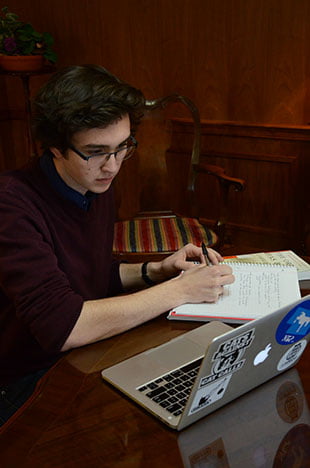
Designed to challenge students and give them an opportunity to research a topic of their choice, Hastings College’s exclusive and competitive Excelsior Scholars Program offers an award between $1,500 and $2,500. Students use the funds to conduct original research alongside a professor who oversees the project as faculty sponsor.
During his freshman year, Brian Whetstone applied for the Excelsior Scholars Program and received $2,500 to conduct his research project entitled “The Persistence of Feme Covert: Uncovering the Women of the Frank House.” Now a sophomore, Whetstone has discovered there is more to his research topic than he first anticipated. By looking at the history of women and the roles they filled in the past, Whetstone identified an overarching problem with house museums and the way they depict women’s roles.
Project focus
The problem started in the year 1860, when the first house museum was created. The Mount Vernon Ladies’ Association was formed to turn Mount Vernon, George Washington’s home, into a museum.
“The model that they created at Mount Vernon, sort of that glorification of Victorian ideals and domesticity and furniture, that is the model that almost every house museum created after 1860 has used and that’s why these problems keep springing up, because the model was inherently flawed,” said Whetstone.
“There are an estimated 15,000 historic house museums in the states,” said Whetstone, “which outnumbers the amount of McDonald’s restaurants we have in the states, so it’s a large problem, too.”
Whetstone’s focus is on three women who either lived in or worked at the Frank House, an historic house museum in Kearney, Nebraska. Those three women are Phoebe Frank, wife of the original owner, George Frank; Eliza Galloway, a former slave who worked at the house; and Georgina Grothan, who owned the house after the Franks and ran a private medical sanitarium with her husband there. Frank and Galloway lived in the Frank House around 1890-1900. Grothan was at the house from 1907 until 1911, when she sold the house to the state of Nebraska.
His work experience and the new director of the Frank House combined to help spark Whetstone’s idea for his project. Whetstone began working at the house museum during his sophomore year of high school and continued there until after his first year of college. Before he left the Frank House, a new director started working there, Dr. William Stoutamire, who did his own research on Galloway.
After Dr. Stoutamire found new information on Galloway, Whetstone became interested in what else had been wrong about the other women. His project began as a women’s history project, and it expanded to include the history of house museums because of his experience.
“It started out seemingly simple and then it turned into this gigantic project,” said Whetstone.
Conducting the research
At first, Whetstone assumed no one had tried to research Frank, Galloway and Grothan. His goal was to conduct that research and figure out why these women had been overlooked. He found although some research had been done, it hadn’t been verified.
The research completed on the men far outweighed the research on the women at the Frank House, and he discovered issues with the way the women were presented through the tour guide narrative and the literature that had been written at the house.
“Finding out about them was a lot easier than I expected and they’re fascinating, all three of them are just very, very fascinating people,” he said. “I realized the further I dug into it, that what has been said about them at the house—there hasn’t been a lot said about them to begin with—but some of what is being said about them is just wrong. It’s just flat out false. I got more interested in why this version of their stories has persisted over such a long period of time—over 43 years.”
In the narrative at the house, it was said Mrs. Frank was a direct descendant of William Penn, she renovated the bathroom for the house and she bought urns for the house to match a light fixture. However, these were all false interpretations.
“Another thing to highlight is that this is changing at the house,” said Whetstone. “The new director at the house (Dr. Stoutamire) is questioning and fact-checking everything, much in the same manner I did, so the narrative at the museum that existed a year ago that I used throughout my research project has completely changed at the museum today.”
Whetstone continues to delve deeper into his research topic. By working with his faculty sponsor, Dr. Michella Marino, Assistant Professor of History at Hastings College, he is learning to formulate and ask tough questions to uncover answers. As well as being inspired by Dr. Stoutamire, Whetstone’s interest in women’s history grew after taking two of Dr. Marino’s women’s history courses during his freshman year at Hastings.
Faculty involvement
As the project sponsor, Dr. Marino oversees Whetstone’s progress, helping him tailor a manageable timeline for him to follow during the summer of 2015 and into his second year of college. Additionally, she gives research suggestions, proofreads and edits his papers, and meets with him regularly to check his progress.
“He has impressed me every step along the way—to the point where I give him feedback, forgetting that he’s only a sophomore,” said Dr. Marino, having worked on the project with Whetstone since March of 2015. “He’s really doing great research and his writing is above and beyond what I could expect for students at that stage in their college career.”
Dr. Marino finds his project fascinating, not only because he is tying different strands of history together but also because she said, “he’s taking his own personal work experience he had before coming to Hastings, taking things he’s learned in various classes, and then actually putting that into action in this original project.”
As she has collaborated with Whetstone on his project, Dr. Marino has enjoyed being part of the Excelsior Scholars Program for several reasons. It has given her the opportunity to team with a student outside of the classroom. Furthermore, she likes that it gives students the chance to broaden their research horizons, especially in an interest that isn’t necessarily taught in a class.
“I think it’s a great opportunity for Hastings students to be able to do this,” said Marino. “I think that’s something unique that we have and it can be beneficial to students and it’s really cool that one year it can be a history student and the next year it can be a biology student. It’s open to various types of research.”
The benefits of independent research
By taking part in this research project, Whetstone said that he has been able to gain insight into research methodology and where to find sources.
“This is the kind of project a historian would do and this is, in many ways, preparing me for a potential career that I might have,” he said. “The sophomore seminar class that historians take, the senior seminar class where they do a research project and then present on it, that’s exactly what I’ve done just in this massive scope.”
After graduating from Hastings College, Whetstone plans on attending graduate school and has been considering applying to the University of Pennsylvania or the University of Delaware to pursue historic preservation, museum work or teaching history at a university.
As part of the Excelsior Scholars Program, the student is expected to present their findings at a competitive national conference or have their findings published in a competitive journal. Faculty sponsors receive funds to travel with the student as well.
Whetstone has considered presenting his research at academic conferences in Omaha, North Carolina and Mississippi. Additionally, he hopes to have his work published in the Yale Historical Review.
“That’s really what I want to get into but there are a ton of other publications and academic journals that I want to get it into. I’ll probably try to shoot for something local, too,” said Whetstone.
